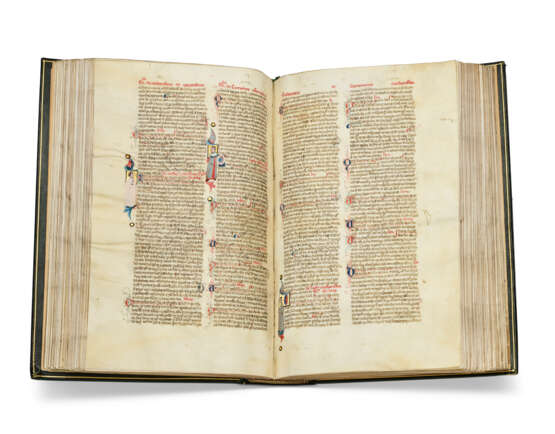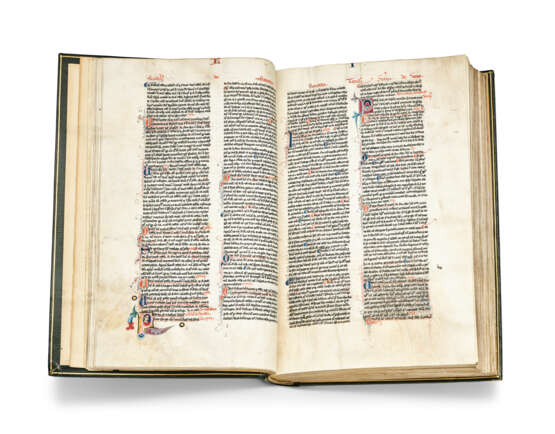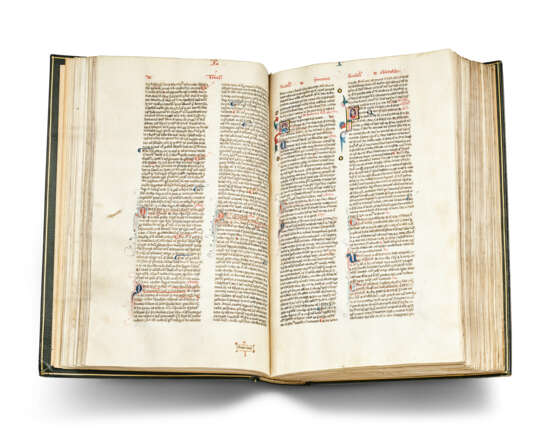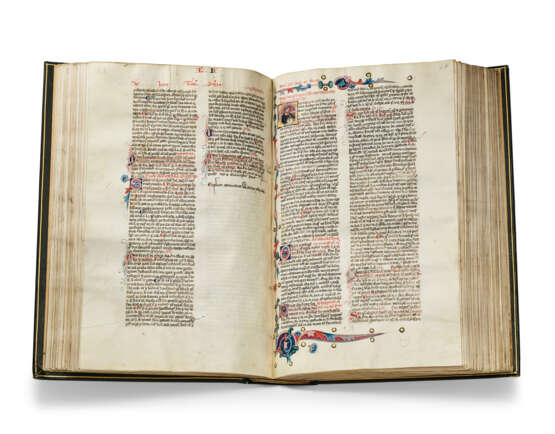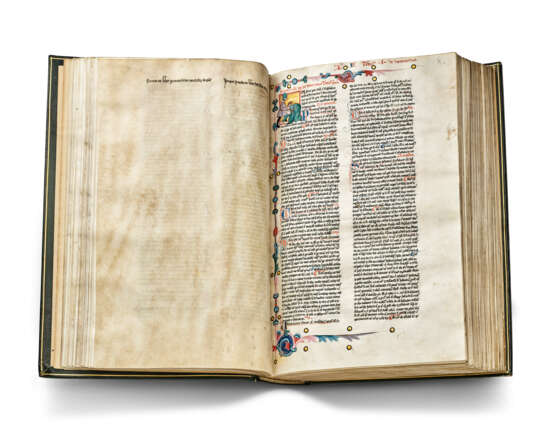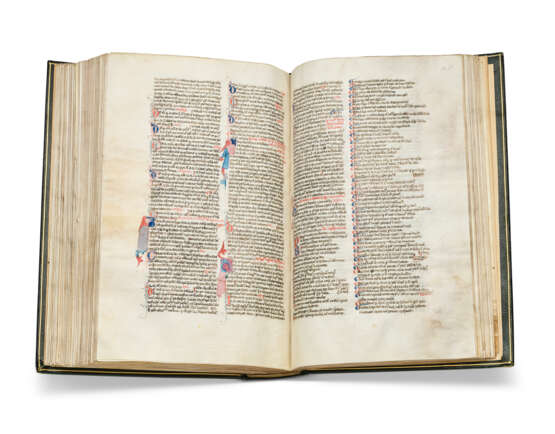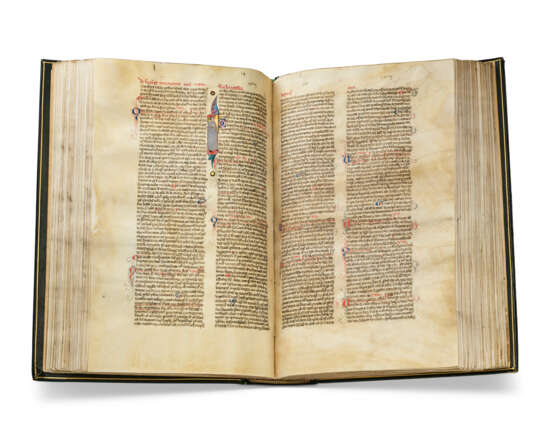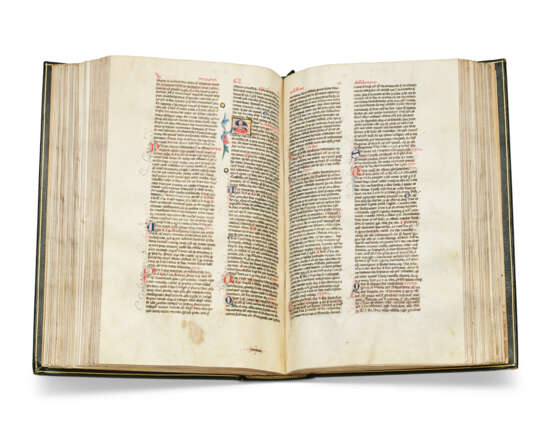ID 1349773
Lot 3 | John of Freiburg (c.1250-1314)
Valeur estimée
£ 30 000 – 50 000
Summa confessorum, in Latin, illuminated manuscript on vellum [Bologna, first quarter 14th century]
A lavishly illuminated Bolognese manuscript of John of Freiburg’s enormously influential penitential manual, produced within only a few decades of the author’s first writing of the text, and possibly within the author’s lifetime.
c.360 x 235 mm. ii + 294 leaves, complete, collation: 1-410, 55 (of 6, i a cancelled blank), 610, 78, 8-910, 10-138, 14-3010, 319 (of 10, x a cancelled blank), two columns of 60 lines, ruled space: c.235 x 70mm, catchwords survive, running headers throughout in blue and red, rubrics in red, paraph marks alternately blue and red, initials alternately blue and red with penwork flourishing in red or blue, 4 full-height illuminated bar borders, 68 historiated initials, of which 6 with full-length human figures, 14 with mythical creatures, a marriage scene, a murder, and the rest with profiles of men, women, nobles and monks, 90 foliate initials (initials on ff.2 and 257 rubbed, some leaves yellowed, a few holes, natural flaws and contemporary stitched repairs, a few creases, else in excellent condition). Bound in 19th-century crushed green morocco richly gilt, gold edges, the spine erroneously lettered: ‘SVMMA RAYMVNDI / MS IN MEMBR.’ (edges a little scuffed, a few scratch marks).
Provenance:
(1) Jean-Baptiste-Joseph Barrois (1784-1855), French deputy and book collector (on whom see Hugh Collingham, 'Joseph Barrois: Portrait of a Bibliophile XXVI', Book Collector 33 (1984), pp.431-48): his MS 68.
(2) Bertram, 4th Earl of Ashburnham (1797-1878): purchased with the Barrois Library in 1849; LXVIII in A Catalogue of the Manuscripts at Ashburnham Place, London 1861. The Barrois Library was Lord Ashburnham's single most important purchase but was only a part of his exceptional collection.
(3) Bertram, 5th Earl of Ashburnham (1840-1913): lot 560 in the Ashburnham Sale, Sotheby's 10 June 1901, to Messrs Ellis.
Contents: John of Freiburg, Summa confessorum, ff.1-294: prologue and tituli for Book I ff.1-2; Book I f.1, Book II f.46, Book III f.92; Book IV f.216v; index ff.257-294; on the burial of monks, excerpt from a Statuta, beginning: ‘Huiusmodi quoque statuto et ordinationibus nostris adicimus ut fratres dictorum ordinum […]’ f.294v.
The Summa confessorum of John of Freiburg (c.1250-1314) is perhaps the most detailed Dominican treatise on confession. He studied at Strasbourg under the Dominican Ulrich of Strasbourg (d.1277), a pupil of Albertus Magnus and Provincial of the Teutonic province from 1272 to 1277. From c.1280 he was lector and prior of the Dominican convent at Freiburg im Breisgau: we see from the rubric and colophon of the present manuscript that he is described as John the Lector. His Summa confessorum was completed before 1298 and draws on Raymund de Peñafort’s Summa de casibus penitentiae et matrimoniae and the moral theology of St Thomas Aquinas, but also from the teachings of other canonists and theologians. This penitential manual aimed to instruct confessors on how to use Canon law and moral theology in their task of carrying out the sacrament of penance.
John’s Summa was a resounding success even during his lifetime. Some 160 manuscripts of the text are extant, and it was printed three times before 1500. According to L.E. Boyle, ‘it is probably fair to state that it was largely through John of Freiburg’s Summa confessorum [...] that St. Thomas’s moral teaching in the Secunda secundae became known and respected throughout Europe in that period’ (L.E. Boyle, The Setting of the Summa Theologiae of St. Thomas, 1982, p.12).
Illumination:
The style of illumination is typical of Bolognese workshops of the beginning of the 14th century: features are highlighted in white, contours of faces are heavily shaded and brows are decisively rendered. There are strong similarities with the work of the Bolognese workshop that executed a Bible in Bologna (Collegio di Spagna, MS 2), as well as a Breviary at the Morgan Library, MS M.0373.
| Artiste: | Johannes Rumsich von Freiburg (XIIIe siècle - 1314) |
|---|---|
| Lieu d'origine: | Italie, Europe |
| Catégorie maison de vente aux enchères: | Manuscrits médiévaux et de la Renaissance, Livres et manuscrits |
| Artiste: | Johannes Rumsich von Freiburg (XIIIe siècle - 1314) |
|---|---|
| Lieu d'origine: | Italie, Europe |
| Catégorie maison de vente aux enchères: | Manuscrits médiévaux et de la Renaissance, Livres et manuscrits |
| Adresse de l'enchère |
CHRISTIE'S 8 King Street, St. James's SW1Y 6QT London Royaume-Uni | |
|---|---|---|
| Aperçu |
| |
| Téléphone | +44 (0)20 7839 9060 | |
| Commission | see on Website | |
| Conditions d'utilisation | Conditions d'utilisation |
